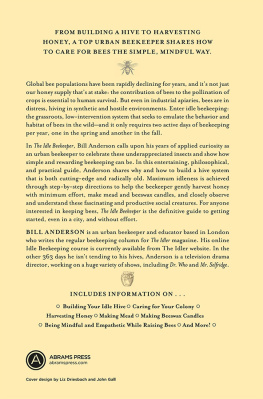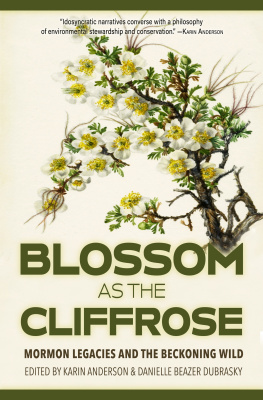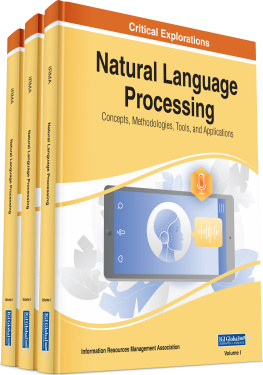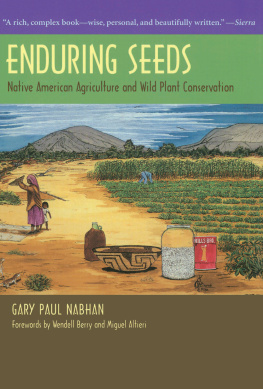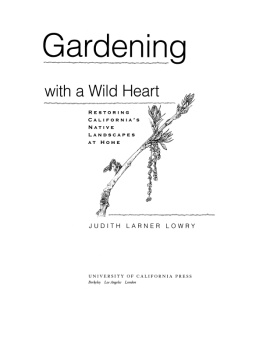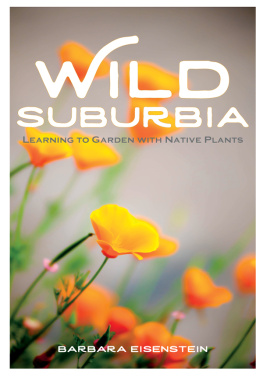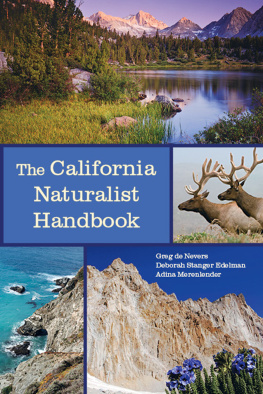Tending the Wild
The publisher gratefully acknowledges the generous contribution to
this book provided by the David B. Gold Foundation and the General
Endowment Fund of the University of California Press Associates.
M. KAT ANDERSON
Tending the Wild
Native American Knowledge
and the Management of
Californias Natural Resources

A portion of the royalties go to Native Americans
to support the rekindling of their land management
practices in certain natural areas of California.
University of California Press
Berkeley and Los Angeles, California
University of California Press, Ltd.
London, England
2005 M. Kat Anderson
Parts of appeared in the article Californias Endangered Peoples and Endangered Ecosystems, published in American Indian Culture and Research Journal 21 (1997):731, reprinted through permission of the American Indian Studies Center, UCLA Regents of the University of California.
Library of Congress Cataloging-in-Publication Data
Anderson, Kat, 1955.
Tending the wild: Native American knowledge and the management of Californias natural resources / M. Kat Anderson.
p. cm.
Includes bibliographical references and index.
ISBN 0520238567 (cloth : alk. paper)
1. Indians of North AmericaAgricultureCalifornia.
2. Indians of North AmericaCaliforniaHistory. 3. Human ecologyCalifornia. 4. NatureEffect of human beings onCaliforniaHistory. I. Title.
E78.C15A676 2005
333.7'089'970794dc22 2004017995
Manufactured in the United States of America
12 11 10 09 08 07 06 05
10 9 8 7 6 5 4 3 2 1
This book is printed on Natures Book, which contains 50% post-consumer waste and meets the minimum requirements of ANSI/NISO Z 39.481992 (R 1997) (Permanence of Paper).
To my parents, Jan and Andy, and to the original
teachersthe native plants, animals, and ancestors
of California
Plants are thought to be alive, the
juice is their blood, and they grow.
The same is true of trees. All things
die, therefore all things have life.
Because all things have life, gifts
have to be given to all things.
WILLIAM RALGANAL BENSON, Pomo,
in E. M. Loeb, Pomo Folkways
Contents
Illustrations
Maps
Figures
Tables
Preface
The idea that would become the foundation of this bookthat indigenous peoples stewardship of the land carries important lessons for us in the modern worldgerminated in my mind as I stood in a Mexican farmers fields in summer 1983. Growing alongside the many kinds of crop plants were a variety of native herbs and trees. Insects buzzed and clicked, and birds chattered. The land smelled good and radiated beauty. The farmer was using the land quite intensively, yet much of the natural plant and animal diversity remained. He explained to me the importance of diversifying crops, using locally available resources, retaining overstory trees, and planting vegetation that harbored beneficial insects that would feed on the bad insects. All these farming techniques were starting to catch on among organic farmers in the United States and to be taught in the new field of agroecology at American universitiesand they all had roots in the farming methods of the indigenous people of this and other regions.
I began to wonder about the ways in which the native peoples of my home state, California, had managed wildland resources and altered the composition and structure of plant communities to meet their needs for food, clothing, and shelter. Had we underestimated their knowledge and ingenuity, their ability to transform their environment, just as we had underestimated the value of the indigenous-based traditional farming methods used around the world? I became determined to find out and decided to focus my graduate study in Wildland Resource Science at the University of California, Berkeley, on what I began to call the indigenous resource management practiced by the first peoples of California. I spent many months over a seven-year period, 198692, in the Sierra Nevada living in towns such as El Portal, Arnold, and North Fork and interviewing individuals from the Southern, Central, and Northern Sierra Miwok; the Mono from Dunlap, North Fork, and Auberry; and the Choynumni, Chukchansi, Wukchumni, and Yawlumne Yokuts tribes. In later years I spent time among the Pit River and Washoe. I also interviewed longtime non-Indian residents, many of them from established ranching families.
The more elders I talked with, the more I appreciated the importance of what I was learning. The fieldwork involved capturing elders memories, their stories of how the land used to look and feel and how it differed from what one sees today. I was excited to hear their descriptions of the Old Ways of relating to natureespecially the management techniques (e.g., burning, pruning, tilling, weeding, and selective harvesting) that they had learned from their parents, grandparents, and great-grandparents and that they were still practicing today.
Several important insights were revealed to me as I talked with elders and accompanied them on plant gathering walks. The first of these was that one gains respect for nature by using it judiciously. By using a plant or an animal, interacting with it where it lives, and tying your well-being to its existence, you can be intimate with it and understand it. The elders challenged the notion I had grown up withthat one should respect nature by leaving it aloneby showing me that we learn respect through the demands put on us by the great responsibility of using a plant or an animal.
Many elders I interviewed said that plants do better when they gather them. At first this was a jarring ideaI had been taught that native plants were here long before humans and did best on their own without human interferencebut it soon became clear to me that my native teachers were giving me another crucial gift of insight. California Indians had established a middle ground between the extremes of overexploiting nature and leaving it alone, seeing themselves as having the complementary roles of user, protector, and steward of the natural world. I had been reading about how various animals interactions with plant populations actually benefited those plantshow grizzly bears scattered the bulblets of Erythronium lilies in the process of rooting up and eating the mature bulbs, how California scrub jays helped oaks reproduce by losing track of some of the acorns they buriedand it seemed plausible that the many generations of humans in Californias past had played a similar role. If it was true that native plants did better with our help, it meant that there was a place for us in nature.
About halfway into the years of fieldwork, I began to ask native elders, Why are many plants and animals disappearing? Their answers, which always pinned the blame on the absence of human interaction with a plant or an animal, began to add up to a third major insight: not only do plants benefit from human use, but some may actually depend on humans using them. Human tending of certain California native plants had been so repetitive and long-term that the plants might very well have become adapted to moderate human disturbance. This idea had a very practical corollary: the conservation of endangered species and the restoration of historic ecosystems might require the reintroduction of careful human stewardship rather than simple hands-off preservation. In other words, reestablishing the ecological associations between people and nature might be appropriate in certain areas.
Next page






